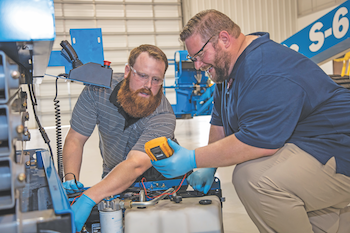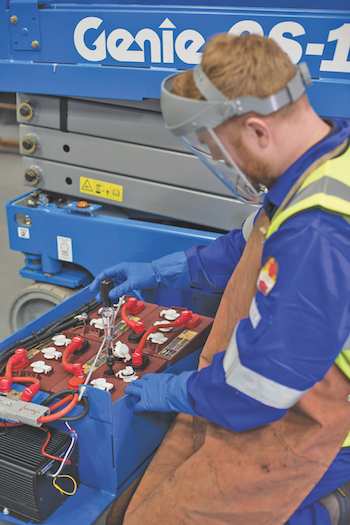Service Tips -- MEWP preventive maintenance
Tips to assure aerial equipment reliability.
By Ron Wixon
Having worked in the Genie field and phone support area for more than 20 years, I’ve noticed a couple of things about machine reliability: It’s simple to help ensure mobile elevating work platforms (MEWPs) perform consistently and for a very long time. For example, many Genie lifts manufactured in the 1980s are still in operation, thanks to savvy ownership.
 |
| More than a check-the-box exercise, scheduled inspections and preventive maintenance are the best ways to help guarantee top MEWP performance. |
 |
|
To maximize your rental return on invested capital (rROIC), look to the original equipment manufacturer (OEM) for the best ways to keep your rental fleet up and running. |
To increase your equipment’s reliability and productivity in the field, please follow these best practices:
Periodic maintenance
More than a check-the-box exercise, scheduled inspections and preventive
maintenance are the best ways to help guarantee top MEWP performance. It enables you to identify small problems before they grow and take the unit down.
For example, minor damage to a component, like a leak in a hub that will grind up if unchecked, damage in a boom tube that becomes a crack or a neglected cable adjustment that allows a cable to jump off the sheave, are all preventable. Potential reliability issues are cheaper and easier to fix the earlier they’re spotted.
OEM parts
To maximize your rental return on invested capital (rROIC), look to the original equipment manufacturer (OEM) for the best ways to keep your rental fleet up and running.
When it comes to replacement parts, the individual costs may seem small, but their impact on a machine’s uptime is enormous.
Replacement parts that aren’t factory-originated might physically fit, but they may not work as well and often cause downtime. Joysticks, for example, can cause issues — they can be the wrong style; won’t work with your unit; work poorly by operating in one direction but not another; or work for a very short period of time.
Because MEWPs are some of the most frequently requested and rented equipment in your fleet, you don’t have the time or money to deal with downtime and failures caused by parts that aren’t specified for your Genie machine. This can be avoided by using genuine parts purchased from the OEM, like Genie genuine parts.
Performance tracking
Some aerial fleet owners prioritize tracking downtime or parts availability to indicate aerial reliability trends. They are closely related because waiting on parts to arrive and installed are the major cause of unplanned downtime. A rental center’s ability to quickly order and receive OEM parts, the age of units and your OEM’s capability to provide fast and efficient service are important factors for equipment reliability.
Cost tracking
Tracking the cost of parts is also an indicator of the equipment’s total cost of ownership. An engine failure, or sometimes just a pump replacement, may be a signal that the cost of ownership curve is no longer sufficiently profitable.
Although some engines may have an advertised life of around 8,000 hours, boom tubes and the chassis don’t wear out unless damaged, so it’s a misconception that machines simply have a standard maximum age or hours of life — these types of parts failures are often a sign of poor maintenance and can signal future issues.
The reality is that following best practices for the care of your MEWP fleet can save your rental business money. By completing the steps outlined in these tips, you can positively impact the residual value and on-the-job performance of your MEWPs, as well as influence your customers’ perceptions of your rental business and equipment.
Ron Wixon is national account manager at Genie - Terex AWP.
Copyright 2018 Direct Business Meia, LLC. All rights reserved.








